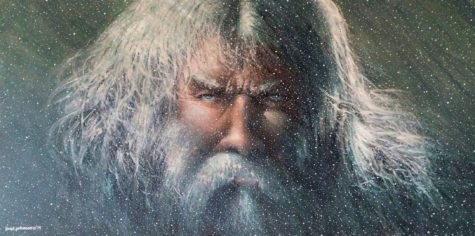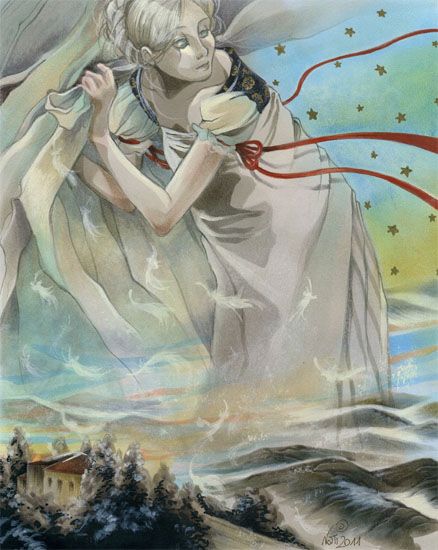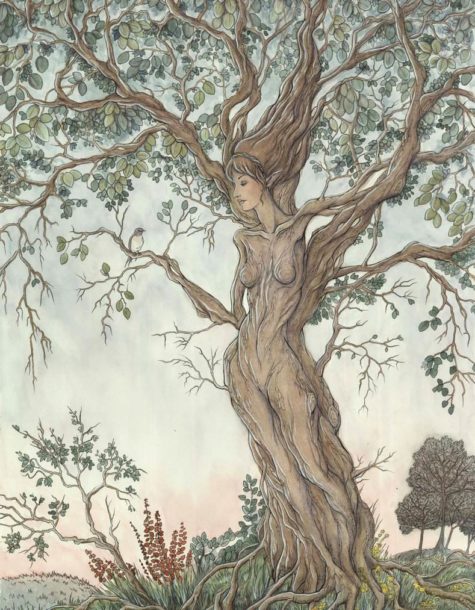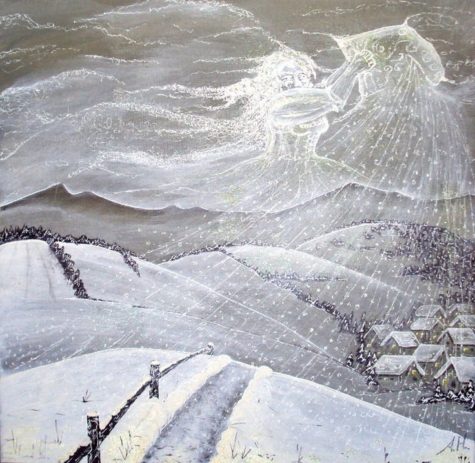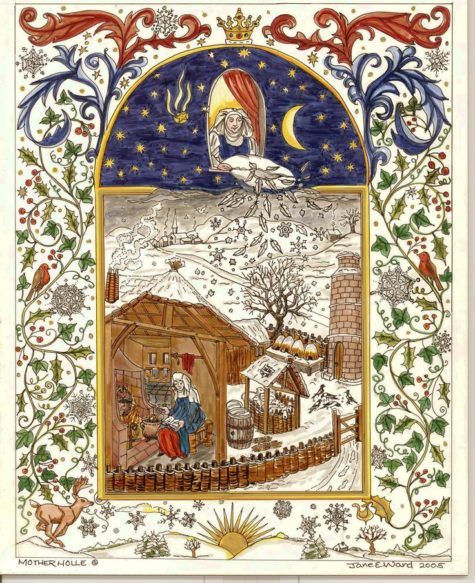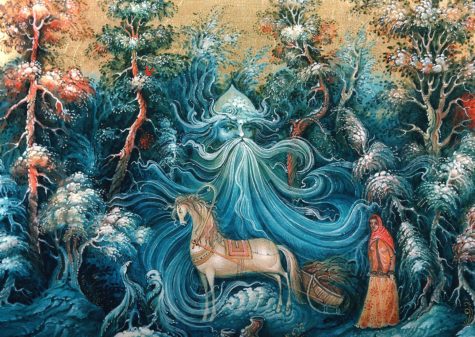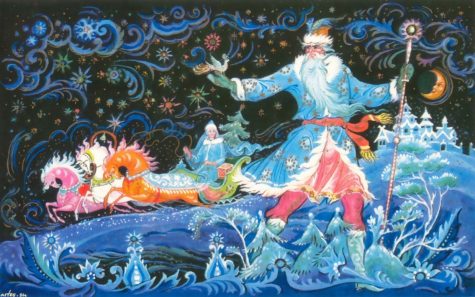Snow
Holder of the Oath Ring; The Silent One
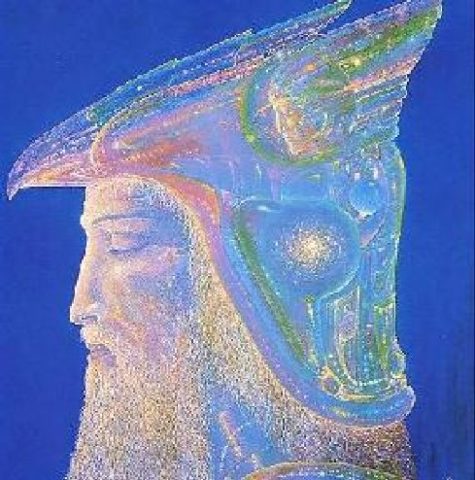
- Also known as: Oller, Ull, Uller, Ullr, Vuldor
- Origin: Norse:
- Rune: Ihwaz
- Tree: Yew (Holler’s home is Ydalir, Yew Tree Valley)
- Favored people: Holler likes the ladies. Skiers love Holler and he seems to love them right back.
Holler is the Lord of Frost and the King of Winter. He is a particularly primordial Norse deity, a mysterious, shadowy spirit. It’s unclear exactly where he sits on the Aesir / Vanir spectrum. Holler may be the son of Sif, the Golden-Tressed One. His father, if any, is unknown, although some suggest that he is of Frost Giant descent.
Holler’s name may be related to “glory.” He seems to have been venerated throughout Scandinavia, the Germanic lands, and the British Isles. According to some myths, when Odin goes wandering, he leaves Holler in charge of Asgard.
Holler is a master archer and hunter and a brilliant skier. Holler skis through the heavens, leaving stars in his wake. He controls the Aurora Borealis. Holler is the lord of justice and dueling. Allegedly invoking his name before a duel brings good luck. When he’s not zipping over the snow on his skis, Holler travels in a ship made from bone.
Holler the Hunter has associations with death. His sacred tree, the yew, is a funerary tree, found in grave yards, not least because of its poisonous berries. Holler may have hunted with poisoned arrows. He may be married to Hulda, weather goddess of birth and death. Like her, he is now associated with the Wild Hunt, and a more negative connotation as the God of Death, Disease and Devastation. It is said that he drags the doomed to his darkest dungeon and delights in dealing out disaster and destruction.
Post-Christianity, many of his more benevolent functions seem to have been transferred to Saint Hubert.
Source: The Encyclopedia of Spirits
- Also known as: Mother Holle, Frau Holle, Hulde
- Origin: Teutonic
- Realms: The sky, underground, mountains, wells
- Constellation: The Milky Way is the street she travels
- Elements: Earth, air, water
- Sacred animals: Wolves, Rabbits
- Color: White, blue
- Spirit Ally: Odin, with whom she sometimes leads the Wild Hunt
- Plants: Holly, elder, juniper, mugwort, flax, Sorcerer’s Violet (Vinca major – sometimes called Frau Holle)
- Sacred Days: The Winter Solstice is Hulda’s feast day. The twelve days between Dec 25 and Jan 6 are sacred to Hulda.
- Offerings: She loves music and dancing.
Manifestations:
A radiantly beautiful blond woman or a fierce old crone. In her guise as Queen of Witches, she has disheveled hair and a wild look.
She may also manifest as a woman when seen from the front but a tree from behind. She may be accompanied by an entourage of torch bearing rabbits who light her way.
About Hulda:
Hulda, a great and ancient goddess of birth and death, presides over a transit station for human souls, a crossroads between life and death. Hulda receives the souls of the newly dead into her realm and releases newborns to live new lives on Earth. Hulda bathes at midday in a fountain from which babies emerge, a well of life.
She was no unknown spirit but a prominent Northern European goddess. Holland is her namesake. Her name may be related to “holy.” Hulda lives in mountain caves and among elder trees, portals to her realm. Her realm may also be accessed via wells. She is sometimes witnessed walking alongside rivers or mountain paths, alone or accompanied by an entourage of rabbits and Fairies. She may be Queen of the Elves.
She plays a prominent part in German folk-lore and superstition. In stormy nights she can be often heard flying through the air, accompanied by weird spirits and witches. On such occasions it is dangerous for ill-doers to be abroad, as they will surely meet with severe punishment; while to the good she frequently appears as a benefactor. Her particular season is winter.
Hulda is a weather spirit. When she shakes her feather bed, it snows on Earth. Rain falls from her laundry rinse water. Fog hovering over a mountain may be smoke from Hulda’s fire. She guards and nurtures all the growing things of the forest. She was a culture-goddess, too, credited with introducing flax to Europe and teaching the art of making linen.
Banished after official conversion to Christianity, people were forbidden to venerate or contact Hulda. Those maintaining that practice were branded witches. Hulda was reclassified as a demon witch-goddess who attacked and harmed children.
She retains dominion over Pagan babies. People were urged to baptize their babies lest they end up in Hulda’s realm. Mother Holle, once so benevolent was transformed into a monster. People warned their children that if they weren’t obedient, Hulda would “get” them.
Vestiges of rituals invoking Hulda’s blessings on baby girls were retained by Ashkenazi Jews (the Hollekreisch), whether because Pagan women found discreet safety in that community rather than convert to Christianity or because Jews perceived Hulda’s resemblance to Lilith. Although rituals survive, many would be shocked and horrified to realize that they invoke a Pagan goddess.
Like Lilith, Hulda is not always so benevolent these days. She is a proud and resolutely Pagan spirit with little patience for hypocrites. Hulda can bestow fertility but she can take it away, too. She has power over storms, raising them as well as soothing them. She can be ambivalent toward people as demonstrated by Mother Holle, the Brothers Grimm fairytail in which she stars.
The theme involves young girls who wander into Hulda’s domain, either inadvertently or deliberately in anticipation of a reward. She rewards the girl who respects her and follows her commands with effort and devotion but causes excrement to rain down upon the lazy, disrespectful girl.
Found in:
- Encyclopaedia of Superstitions, Folklore, and the Occult Sciences
- The Encyclopedia of Spirits
- Names: Father Frost
- Manifestation: Morozko signals his presence with the abrupt sound of ice cracking or trees snapping from the weight of snow.
- Attributes: An icy scepter; anyone who touches his scepter instantly falls asleep and will allegedly never awake.
- Daughter: Snegurochka – The Snow Queen.
Morozko is responsible for the ferocity of Russian winters. Whatever he touches with his staff instantly freezes. Morozko can raise or lower the temperature and cause snow to fall. Morozko is petitioned for snow and for safety from snow.
In a famous Russian fairy tale, a step-mother sends her step-daughter out into the forest at night, assuming that Morozko in the guise of freezing weather will kill the girl. Morozko does find the girl, but when he inquires whether she’s cold, the girl answers so politely and bravely that even his cold heart is touched.
Father Frost makes her a fire and sends her home with gifts the next morning.
The step-mother then sends her own daughter out into the woods at night, presuming that she’ll come home with valuable gifts, too. The spoiled girl whines and complains to Father Frost, who lets her freeze to death.
In 1966 the Russian film “Morozko” features a kinder, gentler Father Frost. He doesn’t kill the step-sister, only humiliates her.
Found in: The Encyclopedia of Spirits
Ded Moroz or Father Frost, the Slavic version of Santa Claus, long ago became the symbol of Russian winter, New Year’s and presents. He is usually accompanied by his granddaughter Snegurochka riding with an evergreen tree in a traditional Russian troika, a sleigh drawn by three horses abreast.
Ded Moroz is a Slavic fictional character similar to that of Father Christmas. The literal translation is “Old Man Frost”, often translated as “Grandfather Frost”. Ded Moroz brings presents to children and often delivers them in person on New Year’s Eve.
Ded Moroz is accompanied by Snegurochka the “Snow Maiden”, his granddaughter and helper, who wears long silver-blue robes and a furry cap or a snowflake-like crown. She is a unique attribute of Ded Moroz, since similar characters in other cultures don’t have a female companion.
The original Russian gift-giver was Saint Nicholas, the country’s Patron Saint, whose Feast Day is celebrated on December 6th. The image of Saint Nicholas originates from the image of another hero – the ancient Morozko. In Russian folklore Morozko is a powerful hero and smith who chains water with his “iron” frosts. Morozko was not hostile to people – he helped them and presented them with awesome presents.
In fairy tales Morozko is at times kind and at times evil. To be precise, he is kind towards the hard working and the good-hearted, but extremely severe with the mean and the lazy. And it is not about justice only. It is rather about two personalities living in one magical person.
Read more about Morozko here: Morozko
Ded Moroz and the Communists
In 1917, with the Bolshevik Revolution, Ded Moroz was banished into exile. He was considered a kind of a kids’ god, which was impermissible during Soviet times when Russian leaders were flatly against any manifestations of religiousness. But only 20 years later Ded Moroz returned to the country and New Year’s celebrations became public. Since then Ded Moroz and Snegurochka appear on New Year’s Eve, putting presents under the fir tree for the kids to find in the morning.
Visiting him at home
Those wishing to make acquaintance with Ded Moroz in his domestic surroundings can board trains and travel to the picturesque town of Veliky Ustyug in the Vologodsky Region of Northern Russia (approximately 500 miles northeast of Moscow) where, situated in the dense taiga forest at the confluence of three rivers, sits the log cabin of Ded Moroz.
There, in Veliky Ustyug, Ded Moroz waits through the summer reading letters that kids from all over the country have written to him regarding the presents they wish to find under the New Year’s Tree the next January 1st.
Characteristics
Ded Moroz has a number of distinguishing features. His shirt and trousers are made of flax and are usually decorated with white geometrical ornamental patterns. His fir coat is ankle long and is embroidered with silvery stars and crosses. His a semi-round fur hat is often red and embroidered with pearls. He has a long white beard.
Ded Moroz wears mittens and a wide white belt. His footwear is luxurious – high boots with silver ornamentation, but on an exceptionally chilly day Ded Moroz can opt for valenki!
And finally he never appears without his pikestaff – made either of silver or crystal, it possesses a twisted gripe. It helps the not-so-young Ded Moroz make his way through the deep dark forest during long winter nights.
Sources: Russiapedia and Wikipedia
